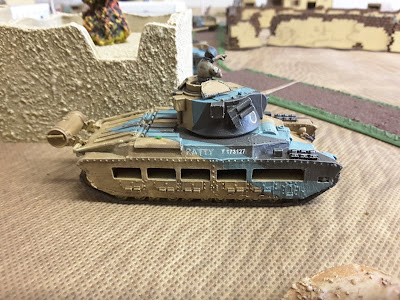The scenario I chose to play was "Counterattack" from Thomas' One Hour Wargames. The rules were the updated version of With MacDuff to the Frontier. Prince August's series of homecasting moulds provided the armies.
 |
| The Nordmark Naval Regiment stands alone. |
Rather than roll on the 6 unit chart, I prefer to roll twice on the 3 unit chart. That way, there is at least a chance of having an all arms force.
In the event, Blue rolled up 3 infantry, 2 cavalry, and 1 gun while Red rolled up 3 infantry, 1 light infantry, 1 cavalry and 1 gun.
 |
| After what felt like an eternity of artillery bombardment, cavalry charges and musket volleys, the Nordmark Naval Regiment was relieved to see the rest of the Alliance forces arrive. |
 |
| The battered Naval Regiment has pulled back into reserve while the Alliance cavalry has met a Rossish cavalry charge and smashed it. |
The main thing I wanted to do was to test my newest attempt to get my rally rules working smoothly. The rally rule has caused me the most problems over the years while also doing exactly what I wanted it to do. At its most basic, the idea back in 1995 was that not all "hits" were dead and wounded but included all those things that lower a unit's efficiency from men who have frozen up or been temporarily stunned, to disorder and confusion in the ranks to temporary ammo shortages and so on. Therefore I allowed units to try to recover casualties when the unit rallied. I got a lot of push back from people who could only see wargame casualties as dead and wounded but that wasn't the problem.
The problem was twofold. One issue was the logistics of tracking an increasing trail of bodies while waiting for a unit to rally and needing to differentiate between those who failed their rally and were out of the game and those who were still waiting for their chance. The second, more important issue, was that successful rally rolls prolonged the game, 5 hours was not unusual for larger games but having to make a decision about who won when time ran out was even more common.
After some fierce fighting the Rosmark forces have been flanked and driven back with heavy losses. |
 |
| An attack by the Rossish reserve regiment has driven the Alliance cavalry back over the ford but Rosmark has taken many more casualties and half of their units have been driven from the field. |
Recently, an obvious solution finally occurred to me. All I had to do was separate "reforming", which is an action which is done instead of shooting or moving, from "rallying" which has to do with morale and losses and can be done at the end of each turn and can be at the end of a turn without taking much away from the game.
 |
| The Garrison of Smalltown make a brave stand to give the army a chance to escape. |
This was the first MacDuff game using the new approach though I used it successfully last week in my non-MacDuff 54mm game. It worked again in this game. Its not perfect, and sometimes the end of turn rally seems little different from a traditional saving throw made immediately when the hits are taken but if a unit takes hits early in a turn, the difference can be critical and from a purely "game mechanic" perspective, it works and is close enough to the original idea for me.

























